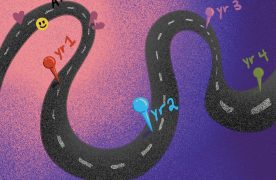I remember the first time I went to SeaWorld — August 2012 in San Antonio. I couldn’t believe that it took me 19 years to get to this typical youth destination, but alas, my childhood curiosity finally took a hold of me. The minute my aunt and I set foot into the park, we began sprinting to catch the afternoon showing at the Shamu Stadium.
Seeing an orca was such an incredible experience. Their sheer size was breathtaking — especially when in close reach of their trainer. I was mesmerized and continuously clicked my camera in hopes of getting the perfect shot of a killer whale jumping majestically out of the water. And that’s when it hit me.
When Free Willy came out in 1993, people were all about the liberty of killer whales — how they deserve an unperturbed life, frolicking in the seas. Now, I’m sitting here, watching these regal beings for live entertainment?
The documentary Blackfish came out three months after my visit to SeaWorld and I was reluctant to watch it because I assumed it was all just propaganda. I’ve never seen the film, but in light of California’s potential bill that could ban the orca shows at SeaWorld in San Diego, I finally decided to watch it for myself.
Blackfish sure has the power to control your mood. And when I turned off the movie, I was utterly infuriated. As someone who has purchased a stuffed Shamu, I felt deceived.
I don’t like playing devil’s advocate, but after working at an aquarium and taking courses in marine science, I felt the need to defend the need to have animals in captivity.
Many naysayers would claim that the best to way study the behaviors of these charismatic megafauna is to study them up close in a controlled environment. This would probably be a good idea if the animal wasn’t 30 feet long and had to go around its sad, lonely tank 1400 times to equate to the distance a wild orca travels in one day. If you’re going to study an animal that hasn’t had a change in scenery in years, you might as well conduct a study on humans in solitary confinement and deem that as representative behavior of the human race.
It doesn’t go both ways.
The movie Blackfish focuses on the orca Tilikum, who currently resides in captivity in SeaWorld Orlando. Tilikum has been connected to the deaths of Keltie Byrne in 1991, Daniel Dukes in 1991 and Dawn Brancheau in 2010. While the movie heavily focuses on the most recent death of Brancheau, all three deaths are utterly tragic and appalling.
That being said, Tilikum is not a monster. His actions are a result of his freedom being robbed from him as well as being forced to swim around in circles daily and do tricks.
Upon reviewing my pictures from the Shamu Stadium, I couldn’t help but notice that the whales in the show had sagging dorsal fins or the more official term — dorsal fin collapse. This occurs in 100 percent of the captive orcas in SeaWorld due to the shallow pools and the force of gravity acting upon their fins. This only happens to 1 percent of orcas in the wild.
Upon tweeting about #Blackfish, I received a lot of positive feedback. For someone that gets an occasional ‘favorite’, I was astounded when several people replied giving me statistics and a gratuitous amount of information.
I was contacted by Jim Smith, the founder and director of SeaWorldPledge.org, a website devoted to informing people about the detriment of marine mammals in captivity and helping them to make an informed decision to take the pledge to not go to a whale or dolphin show. Smith’s passion toward spreading awareness and education about Cetaceans in captivity is infectious and inspiring.
Smith explained that, “the reach to younger audiences, which are and will be the target market for SeaWorld,” was the impetus behind the success of Blackfish. If the California bill is successful, the 10 orcas at SeaWorld San Diego would undergo a rehabilitation/ release program or a, “retirement to attended sea pens for those not eligible for release.”
“If you place an Orca in an environment where other free ranging, wild orca are present, he will begin to vocalize and try to find a relative in the area,” Smith described. “At some point the innate nature of any living things instincts kick in and an Orca will again become an Orca.”
On his website, Smith is not only adamant about the freedom of orcas, but dolphins as well. Why? Because it is our duty to stick up for animals that can’t speak up for themselves.
Imagine yourself in a 9.5 meter by 5.7 meter by 2.1 meter and you have a human equivalent of an orca’s pool. Anyone who was subjected to a lifetime in that box after being able to roam free in the wild would surely go mad.
The words from the beginning of the film echoed in my head even after the movie ended. In the orca’s eyes is a broken soul, a wild spirit that is slowly dying.
“When you look into their eyes, you know somebody is home,” said John Jett, a former SeaWorld trainer featured in Blackfish.
In my interview with Jett, he recalled the moment when he realized that things at SeaWorld are not as perfect as they seem.
“I remember calling my father after my first day to express my concerns,” Jett said. “Like all new trainers, my first day on the job consisted of preparing “buckets” for the whales, among other duties…I was given baggies of medications to stuff into their fish for ‘morning meds’. This was a red flag for me.”
Jett said his involvement in Blackfish was certainly life changing as it has allowed him to educate the public about something that he is extremely passionate about— “the realities of life in a concrete tank”.
According to Jett, Sea World lies to its staff as well as their guests.
“We learned how to divert difficult questions… in short, we were forced to adopt SeaWorld speak,” Jett described. In a segment of Blackfish, it is noted that docents exaggerate the life span of the orcas in captivity.
Keeping animals in captivity statistically leads to a shorter life span. According to Whale and Dolphin Conservation, 92 percent of SeaWorld’s orcas do not survive past the age of 25. The average life span for an orca in the wild is 50 for females and 30 for males, and some have been known to live 80 to 90 years.
While the California bill sets out steps for rehabilitation for just orca in captivity, this bill (if passed) will revolutionize how we view not only animals in SeaWorld, but in aquariums too. I took the SeaWorld Pledge because SeaWorld’s callous approach to the detriment of their animals is a travesty and their obsession with taming the wild is something that is simply unprecedented.
Although the success of the Blackfish Bill is in the air, finally giving an authoritative voice to these powerful, majestic creatures is a step in the right direction.
This is an account occasionally used by the Daily Free Press editors to post archived posts from previous iterations of the site or otherwise for special circumstance publications. See authorship info on the byline at the top of the page.














THERE ARE CERTAINLY SEVERAL SIDES TO OCEANARIUMS AND DOLPHIN WHALE SEA LION SHOWS ALONG WITH PERFORMING ELEPHANTS LARGE CATS AND CIRCUS TRAINERS COLD BRUTAL UNFEELING ON AND ON HOW ABOUT DOGS CHAINED IN THE YARD THAT TOO IS A CAPTIVE ANIMAL BOTHERS ME BIG TIME. I WORKED 25 YEARS AT SEA LIFE PARK AND I KNOW IF YOU EVER TALKED TO PAST TRAINERS THERE THEY WOULD ALL CLAIM IT WAS A GREAT PLACE TO WORK AND I CAN SAFELY SAY DURING MY TIME THERE, WAS NO AGGRESSION OR CLOSE CALLS TO TRAINERS, BUT OF COURSE THERE WERE SOME DISAGREMENTS WITH THEIR NEIGHBOR, WHEN THAT WOULD HAPPEN WE WOULD WAIT UNTIL THEY WORKED IT OUT NO BLOOD AND GUTS JUST SOME TAIL SLAPPING AND PLEANTY NOISE. WE HAD DOLPHINS 40YRS OLD WE HAVE A WOLPHIN. OUR MANAGEMENT WAS THE PITS EXCEPT FOR THE PRYORS WHO STARTED SEA LIFE PARK BUT AFTER THAT IDIOTS.IM NOT SURE YOU CAN TRAIN AN UNHAPPY ANIMAL, I DID NOT HAVE ANY.